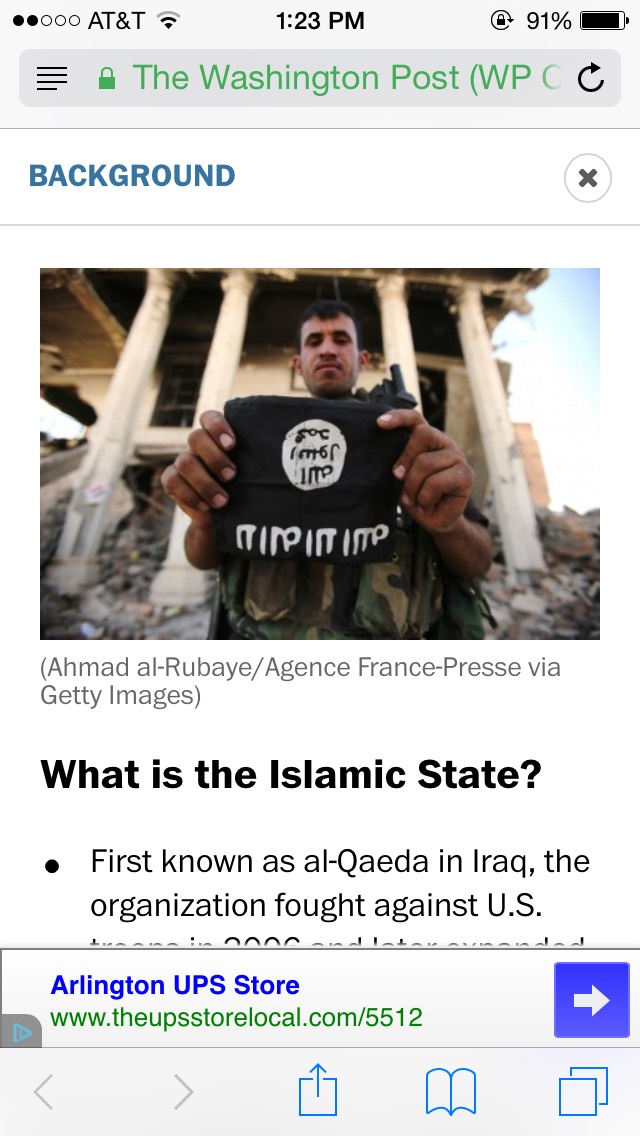How the Islamic State is leaving tech companies torn between free speech and security is a labyrinthine topic. To fully understand it, readers should probably already have a good grasp on the spread of the Islamic State on social media, past acts of terror such as the 2013 Westgate Shopping Mall attack in Nairobi or the shooting at the offices of Charlie Hebdo in Paris, and even just how social media works.
Today’s 8,000-word-plus story on the subject, part of The Washington Post’s “Confronting the Caliphate” series, comes with the background knowledge and context right in the story itself:
The feature, which the Post calls a Knowledge Map, appears as highlighted links and buttons within the story, allowing readers to click on and then read a brief overview of relevant topics like “Anti-Islamic State activism” or “James Foley.”
“We wanted to experiment with providing background information as a user reads a story to help bring context to a complicated topic, and we designed Knowledge Map to work in a way that would not interrupt the reading experience,” the Post’s director of digital strategy Sarah Sampsel said in a press release. “Knowledge Map makes reading the news a more personalized experience, giving readers access to additional information as they need or want it.”
 The feature works on mobile, too: click on a highlighted link, and a window opens within the page that a reader can then exit out of without leaving the story page.
The feature works on mobile, too: click on a highlighted link, and a window opens within the page that a reader can then exit out of without leaving the story page.
For now, Knowledge Map is still a small-scale test, appearing only on this one story. But the Post eventually hopes to apply data mining to personalize the reading experience further for its readers.
“This iteration sets us up to use data mining techniques to identify and surface contextual content for our readers,” the Post’s engineering director for data science Sam Han said in its announcement about Knowledge Map today. “Our ultimate goal is to mine big data to surface highly personalized and contextual data for both journalistic and native content.”
15 comments:
Exactly what is needed-and almost always left out of mainstream media news. Please keep on this track and it will eventually bring other operations along with you!
Experience stress-free travel with Airport Transfer DFW. Our Dallas/Fort Worth International Airport transportation service offers a fleet of luxurious sedans, SUVs, and vans, driven by experienced chauffeurs. Whether it’s an early morning or late-night flight, our 24/7 availability ensures timely arrivals. Enjoy transparent pricing, professional service, and a seamless journey to your destination. Your travel, our priority.
Discover seamless travel with Airport Transfer DFW – your trusted solution for reliable transportation to and from Dallas/Fort Worth International Airport. Choose from a range of luxurious sedans, SUVs, and vans, all driven by experienced professionals. Our 24/7 service ensures timely arrivals, catering to early mornings and late nights. Enjoy transparent pricing, excellent support, and stress-free travel in Dallas. Book now for a hassle-free journey!
We offer quality Private Car Service and drivers to transport you from DFW Airport
Find party bus rentals in Miami, Florida, offering convenient options for your event. Rent a party bus in Miami FL for stylish transportation solutions. Explore diverse party bus rental services to elevate your experience in Miami.
With a focus on group travel, Maryland’s charter bus service offers motor coaches for transportation across Maryland and DC. Their reliable motor coach transportation ensures comfortable and efficient journeys, catering to diverse group transportation needs.
Comprehensive ground transport options for LaGuardia Airport, including shuttle, taxi, rental, transfer, limousine, private car, and executive transport services, ensuring seamless travel experiences.
Elevate your travel with our Los Angeles black car service, providing top-notch transportation to and from LAX for a seamless and elegant journey.
Dubai Hummer Limo offers airport transportation services in Dubai to and from all airports in UAE.
We are dedicated to providing quality Luxury airport transfers, including comfortable and reliable limousine services. We service all over Dubai city.
If you’re planning a trip from Dubai to Abu Dhabi, transportation is an important factor to consider. While there are many options available, limo UAE is a great choice for many reasons. Not only does it offer a luxurious and comfortable experience, but it also provides numerous benefits that other forms of transportation can’t match.
If your wolf microwave oven is not heating your food, you can consider the Subzerorepair247.com care will help you figure out the cause of the problem and how to solve it
Our goal is to provide exceptional maintenance and repair solutions for your Sub Zero refrigerators, all at a price that cannot be matched. Our team of seasoned experts are fully equipped to tackle a wide range of issues, ranging from malfunctioning fans to contaminated oils and damaged compressors. Rest assured that we’ll restore your refrigerator’s cooling system to peak performance.
hire a SEO company in Biloxi that does search engine optimization, you’re investing in your local SEO presence
XESS Offers every client the best in Digital Printing, Vehicle Branding,
Graphics, Signboard, Backdrop, Stage, Exhibition stands, Display and
Popup stands.
Trackbacks:
Leave a comment